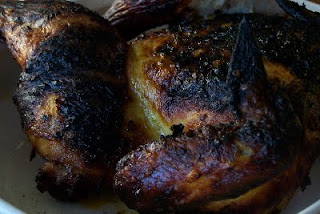Last week when I was browsing World Market for a new ingredient to use and write about, I bypassed siracha and some lovely pink-, blue-, green-, and yellow-striped farfalle that reminded me of ribbon candy and bought a bottle of marinade. I know, right? I should have known better. But I was seduced by its name—tandoori.
I’ve wanted to try tandoori chicken for some time now, but not having a clay-lined pit, or tandoor, in my backyard, or a plane ticket to India, I copped out with something fake. In my defense, I didn’t know it was fake; on the other hand, when it comes to bottled marinade, there’s probably no defense.
I butterflied a roasting chicken, and slathered it with the red stuff from the bottle. It grilled beautifully, but the flavor wasn’t all that great. It didn’t taste bad; it didn’t taste like much of anything at all.
Of course, that’s because it had no yogurt to tenderize the meat and none of the usual tandoori spices—coriander, cumin, red pepper, Garam Masala, and tumeric.
But I couldn’t turn a blog post out of a failed dish. As I re-thought what to write about, I stood at the kitchen counter eating crispy French fried onions. And it struck me—who does that? We’ve probably all eaten those crispy onions in the ubiquitous Thanksgiving green bean casserole. But who else eats them straight out of the can? That’s pretty weird, I thought. I could probably write about weird things I eat. Weirdness is subjective, of course, but still, it’s a topic I could work with. When I brainstormed, however, other than sprinkling salt on apples, I couldn’t think of anything else weird. (I’m not counting calamari, as Kevin suggested I should, as weird. It’s simply delicious.)
It’s a good thing, though, that the risotto Kevin made while I babysat the chicken was not weird in the least. In fact, it was perfect, as was the chocolate tapioca for dessert.
Perfect Risotto (serves 4)
I distinctly remember the first article I ever read about risotto. The writer emphasized the time-consuming nature of the dish and the precise skill needed to ensure that each rice grain retained its individual structure while at the same time morphing with the other rice grains into a creamy showpiece. It scared me for years.
I assure you, however, that risotto is actually quite easy to make, and more forgiving than some would want you to believe. It doesn’t take any more time than it would to cook long-grain rice, and the only skill required is stirring.
One ingredient note: if you don’t use wine, and there are those who don’t, simply omit it. I do not recommend using cooking wine since it contains huge amounts of sodium and will ruin the taste of the dish.
3 cups chicken broth or stock
2 tablespoons butter
2 tablespoons olive oil
1 cup Arborio rice
2 shallots, diced
½-cup white wine
salt to taste
First you will want to start the chicken broth simmering on the back of the stove. Once it’s going, heat the butter and oil in another saucepan over medium heat until the butter stops foaming. Add the rice and shallots and cook, stirring occasionally, until the shallots are softened a bit, but neither they nor the rice is browned.
Pour the wine over the rice and cook, stirring, until almost all the liquid is absorbed. Next, ladle the chicken broth, ½-cup at a time, into the rice mixture. Cook and stir until the rice absorbs almost all of the liquid, and then pour in the next ladleful. And so on, until the rice is creamy, yet each grain is firm. You may not use all the liquid every time, so do taste the rice when there is about half a cup of broth left; if it’s tender, you can be done. Season with a little salt.
The whole cooking and stirring one bit of broth at a time is, I think, the part that was most scary to me when I first read that frightening article. But in reality, though you should not leave the kitchen, or even go more than two steps from the stove, while you’re cooking risotto, you don’t actually have to stir the entire time. If you leave the spoon for a few seconds, disaster will not ensue. Trust me.
Risotto is best served right at the moment it is done. If you find you are not ready to serve it, then you will need to hold off the last few ladlefuls of broth. Simply cover the pan and move it to a cold burner. It will quickly re-heat when you are ready to serve, at which time you can finish it and season it.
One of the beauties of risotto is its endless delicious variations. Sauté diced porcini mushrooms with the rice and shallots at the beginning. Or don’t use shallots at all; use onion. Or leek. Once we made a beautiful purple risotto by using red wine instead of white. At the end, stir in peas and bits of bacon. Parmesan cheese and a little chopped parsley would not be amiss, either.
One other word—after you make this dish, you will never again eat boxed rice that comes with the powdered flavor packets. Unless it’s one of those weird days in which accomplishing anything on your to-do list is giving you fits.





No comments:
Post a Comment